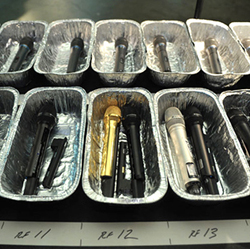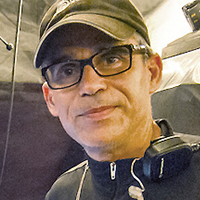So, you’ve done your scan, frequency coordination, antenna placement, walk-around and war-gaming tests, and everything works.
All of your wireless transmitters are resting comfortably in their metal trays, the batteries are good and line check has verified that all of your units are sending audio where they’re supposed to. What else can go wrong?
Well, for one, a presenter or performer can end up with the wrong transmitter in his/her hand at a critical moment. Wireless microphones, being, well, wireless, have a much greater chance of ending up in the wrong place than a mic that’s tethered to a certain spot on the stage via its cable. (Not that I haven’t seen this as well, in the bad old days of horrible, messed-up festival stages where there could be a 50-foot mic cable stretched across a stage at 45-degree angle. But that’s another article…)
Logical Path
Ensuring that wireless hardware is deployed correctly during an event starts with pre-production. If you have control over the racking of the gear on the show build, try to make sure that the equipment is laid out in a logical manner.
My preference is to start with the lowest frequency band gear in the top of the rack and then work in sequence to higher bands as required so that “RF-1” is the top left unit, “RF-2” the top right, and so on.
This ensures that any paperwork generated by a frequency coordination program (or sent out to the network by a management program like Shure Wireless Workbench 6 or Sennheiser Wireless System Manager) will – hopefully – have the transmitters in order from lowest to highest. (I discuss this topic more fully here.)
Once you’re on site, making sure that there’s a suitable tech area to lay out and label all of the hardware is vital. This is typically a table with an area marked out for each transmitter and its corresponding tray. There should also be enough space for one to two laptops, spectrum analyzers, batteries, and above all, the script and/or show run-down.
The next step is allocating the mics. It’s really important to be on top of this during rehearsals, as everyone is going to want to see the same mic(s) that an act rehearsed with used during the show.
My technique is to work through the order (i.e., first up RF-1, then RF-2, and so on) like a baseball batting line-up. There are several reasons for this. First, it helps in making sure that each transmitter gets about an equal amount of use, rather than starting over at RF-1 for each act. This evens out battery consumption and more evenly distributes the possibility of handling mishaps (like a unit being dropped).
Second, it helps to avoid the situation where a mic or mics have to “travel” quickly from place-to-place to make the next cue, as in situations where, say, a presenter walks off stage left with a mic while the next presenter is in the wings, stage right, waiting for that same mic.
Third, there’s sufficient opportunity to wipe down each mic with an alcohol prep pad between use, partly for general hygiene, partly as a courtesy to the talent (which is even better if they see you do this), and partly because even though I don’t own the gear, I treat it like I do because it’s quite likely that I’m going to end up using it again down the road.




















